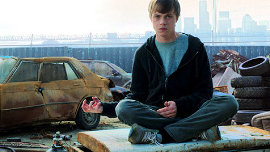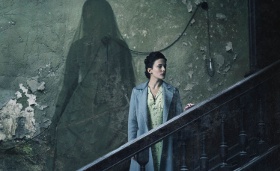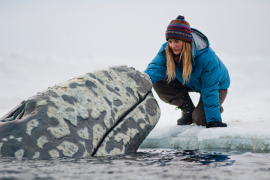 CHRONICLE
CHRONICLE
Part superhero (and -villain) origin fable and part teen-angst melodrama, Chronicle concerns three high-schoolers who venture down a mysterious hole in the Earth and emerge with telekinetic powers, and the best thing about the movie is that its leads subsequently behave just as high-schoolers likely would in such a situation.
Turned on by their newfound abilities to move objects at will, and even more turned on by their shared secret, Andrew, Matt, and Steve use their gifts to pull pranks on unsuspecting passersby and wow the student body at the talent show, and whenever they do, director Josh Trank's faux-doc adventure proves sensationally witty. With the young men recording their every otherworldly feat on an HD camcorder, the film's mostly outstanding visual effects have an offhanded charm and boast considerable surprise; in its lightest, most ingenious moments, Chronicle is like a Hollywood blockbuster re-designed as the ultimate YouTube video. Though screenwriter Max Landis' dialogue is a little (well, a lot) heavy on redundant exclamations of the "Dude, no way!" variety, there's enormous enjoyment to be had in the leads' miraculous antics - especially their only-slightly-mean-spirited terrorizing of a small child with a floating teddy bear - and the infectious thrill they take in them.
Alas, being a modern-day superhero offering, that joy proves predictably short-lived. The majority of Chronicle is instead dedicated to our main protagonist Andrew (impressively played by Leonardo DiCaprio lookalike Dane DeHaan) learning to harness his powers while dealing with an abusive, alcoholic father, a dying mother, and numerous tormentors at school, and his adolescent anguish might've carried more weight if it weren't so depressingly by-the-numbers. For all of Chronicle's wondrously clever fringe touches, every beat in Matt's transition from bullied nerd to vengeful, power-mad warrior lands just when you expect it to, and as a whole, the generally likable cast doesn't possess either the naturalism or the professional skill to make these scenes play as anything beyond genre-pic hand-me-downs. (There's an awful lot of "let's not look like we're acting" acting going on here, and matters aren't helped by nearly all of the student characters looking less like high-schoolers than attendees of a 10-year high-school reunion.) By the time the movie got to its extended, effects- and contrivance-heavy climax, with two of the empowered laying waste to Seattle, I was bummed to see that the film had become indistinguishable from a low-rent X-Men knock-off. I will, however, admit that this might be just what some viewers want it to be; perusing Chronicle's Internet Movie Database page, I landed on a message-board post that found one mitchell94 writing, "WOW, my short film i made is EXACTLY like this!" Given that claim's enthusiasm and spotty, teen-speak grammar, I don't doubt this is true. I'd also argue that that's maybe not an entirely good thing.
 THE WOMAN IN BLACK
THE WOMAN IN BLACK
With the exceptions of the annual Paranormal Activity releases, modern horror movies are generally so obsessed with viscera that director James Watkins' haunted-house saga The Woman in Black feels like a tonic - or rather, it would, if the film's first half-hour weren't such a beautifully designed bore. A post-Victorian tale of a mysterious specter that roams the grounds of a British mansion and inspires the suicides of local children, with Daniel Radcliffe cast as a grieving widower who begins seeing things he should definitely not be seeing, the early, ghostly imagery and hushed threats are evocative but not particularly gripping, and there's just not enough going on in Radcliffe's low-key portrayal for you to fear for his safety or sanity. (It should go without saying that the former Harry Potter is an effortlessly empathetic screen presence, but beyond his inherent sweetness, the actor doesn't bring much to this particular party.) Stick with the movie, though, because once the splendid, frighteningly eccentric Janet McTeer shows up - spoon-feeding her twin pooches in high chairs and carving spirit-world warnings into her dining-room table - the experience perks up considerably. The film may overplay the thunderously loud BANG!!!s and BOOM!!!s on its soundtrack, yet you can get a serious case of the heebie-jeebies merely from its gorgeous, foggy nighttime vistas and restrained motif of deceased children visiting from beyond, and Watkins' initially logy pacing subtly but surely builds in momentum and escalating dread. (The director also pulls off some wickedly inventive shots, such as the glow from Radcliffe's candlestick being reflected in the eyes of a mechanical monkey, making it look as though the simian is actually watching him.) It takes a while to get rolling, but The Woman in Black ends up as quite a bit of old-fashioned horror-flick fun, and whoever was responsible for all of the scary-ass wind-up toys littering the mansion's playroom is deserving of a special ovation. Given all of the period-appropriate and utterly nightmare-inducing animals, dolls, and toothy clowns (!) on view, are we sure all those kids didn't kill themselves on purpose?
 BIG MIRACLE
BIG MIRACLE
Based on the 1988 international-news event that found three gray whales trapped in the ice near Barrow, Alaska, Big Miracle is the rare movie that makes me glad that Hollywood is a veritable hotbed of liberal-bleeding-heart propaganda. (Or, you know, so I'm told.) With ambassadors from Greenpeace, TV newscasters, government officials, greedy oilmen, the National Guard, local Inupiat Eskimos, Minnesota inventors, and even the Russians teaming up to return the mammals to the Pacific, director Ken Kwapis' unapologetically sentimental outing is exactly the sort of heart-tugging family adventure you think/hope/dread it'll be. Admittedly, during its opening scenes, I fell squarely in that "dread" category, especially when it was revealed that Drew Barrymore's Greenpeace activist and John Krasinski's ambitious journalist - stop the presses! - were also former lovers. (To be honest, the romantic leads alone had me dreading the movie. Barrymore is at her most insufferable when she's strident, and her character is awfully strident here, and after so many seasons on The Office, Krasinski may no longer be able to pull off sincerity; every time he makes an earnest declaration now, I wait for him to turn to the camera and stare at us with an ironic deadpan.) But good Lord does this thing have a crazy-good cast! Every time you're ready to write the movie off for its sappiness, another familiar, topnotch actor will show up to breathe freshness and humor into the proceedings, sometimes only for a single scene; among those making incredibly welcome appearances are (deep breath) Ted Danson, Kristen Bell, Tim Blake Nelson, Stephen Root, Rob Riggle, James LeGros, John Michael Higgins, Kathy Baker, Vinessa Shaw, Shea Whigham, Bruce Altman, Gregory Jbara, and Dermot Mulroney. (After his participation in this Alaska-set film and The Grey, I'm hoping Mulroney lands in a nice romantic comedy set in the Caribbean stat.) And while you can roll your eyes aplenty at Big Miracle's bum jokes and stereotyping and typical Hollywood simplification of real-life events, there's no getting around the scenes with the whales - particularly the rare underwater sequences - being legitimately grand. For a few brief minutes, the movie pauses to let us fully take in what awe-inspiring creatures these whales actually are, and perhaps the highest compliment I can pay the film is that, by its finale, Kwapis' offering proves absolutely, unexpectedly deserving of its subject.
 THE LAST REEF
THE LAST REEF
Presenting a 45-minute edu-tainment that may as well have been titled Way Bigger Miracles, the Putnam Museum re-opens the doors to its six-story-high screen with The Last Reef, an underwater documentary on the fascinating and varied creatures living among our oceans' coral reefs. I'll leave it to others to determine if the auditorium's transfer to digital protection and improvements in sound quality are all that noticeable; for my money, the images and sound at the Putnam were always glorious, and I'm just happy and relieved to see the now-IMAX-less operation again open for business. What I can comment on is that directors Luke Cresswell's and Steve McNicholas' deep-sea endeavor is a sprightly, fast-moving, and visually breathtaking endeavor that's blessedly free of the traditional nature-doc corn - the narration, especially, is admirably straightforward - and that the we're-killing-the-planet-but-don't-worry-kids-everything-will-be-fine moralizing is pretty much kept to a minimum. Plus, with its unbelievably vibrant colors and continually astonishing undersea denizens, The Last Reef looks stunning in its 3D presentation. The floating jellyfish were magnificent, but I was even more floored by the sight of a real-life Nemo withdrawing into the billowy tentacles of an anemone, a hiding place only slightly less effective than the shark that provides camouflage for similarly-hued fish. With friends like this, who needs anemones?










